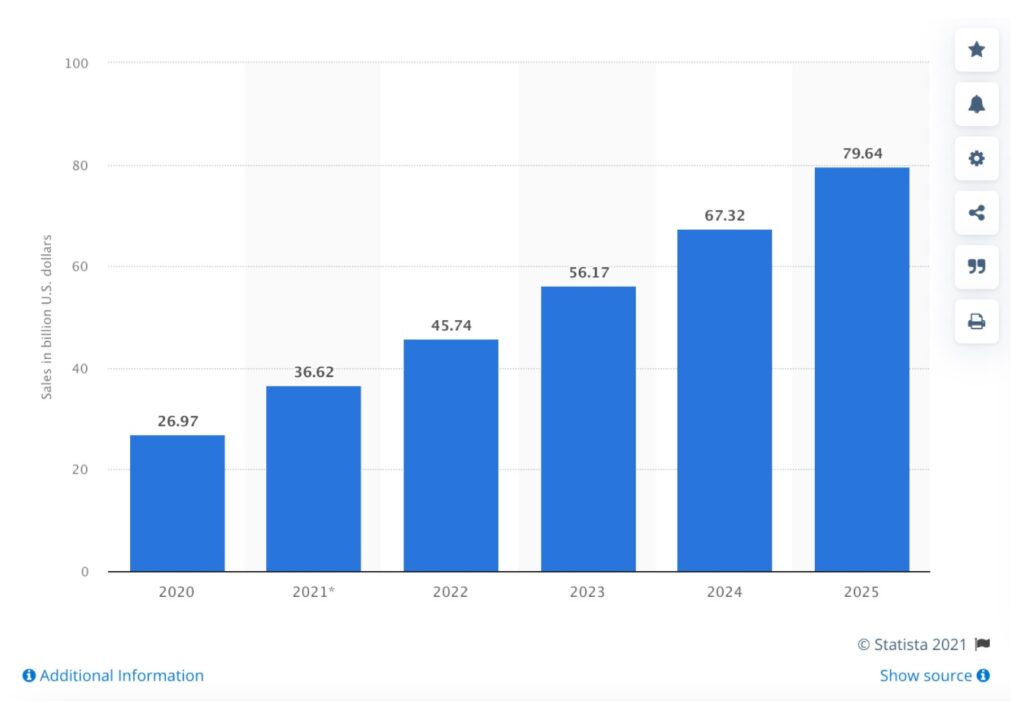According to Statista, social commerce sales in the US in 2020 were estimated at nearly 27 billion USD. As social media’s influence continues to increase, U.S. social commerce is projected to reach 79.6 billion USD in 2025 and account for 5.2% of U.S. retail e-commerce sales. Imagine in South East Asia or in other emerging markets, as more people have more access to the Internet, social commerce sales may have a similar or even bigger increase in the future.

Credit: Statista
But to embrace social commerce, we need to know what it is!
Social Commerce is the entire process of selling/promoting and buying a service or product through social media platforms such as Facebook, Instagram, and Twitter.
Retweets, likes, shares, or stories mentioned are the indicators to determine the success of a social commerce campaign and how the customers interact with the brand.
Social commerce also seeks to engage online shoppers by offering expert product advice and support; eventually, convert these experiences into actual actions with a “call to action”. E.g., hitting the”buy now” button after seeing a pair of Air Jordan 1 with a unique colorway for sale on a Facebook sneaker group.
Credit: Photo by Wojtek Pacześ from Pexels
You might have heard of E-commerce instead of social commerce. The main difference between these two is that social commerce is a subset of E-commerce. The former involves social media and online media platforms that support social interaction, whereas E-commerce means buying and selling goods, products, or services over the Internet.
Some experts believe that social commerce is leading the future of E-commerce. Because brands and retailers can use social media features to create engaging, shareable, and immersive advertisements that help products and services go viral in a short time. Therefore, if brands start making more use of social commerce early, they will have more advantages in taking the lead of the competition in the industry!
“Yes, yes, I know what social commerce is now, but how can it benefit my business?” Glad you asked! Social commerce provides a more effortless journey for the customers from product discovery to purchase, and it can help the business by:
With the more social media platforms you use, there must be more incoming messages all over the place. Of course, one should be happy with more business inquiries. However, it could become chaos if you have not established an efficient system to support all the queries without any delay. To avoid dissatisfying your potential customers, let me introduce one social commerce magic tool.
SleekFlow is an Omni-Channel Social Commerce Platform that helps you, the business owners, manage communication channels such as WhatsApp, Facebook Messenger, WeChat, Line, Instagram, Live Chat, SMS, and Email in one place. SleekFlow helps manage contacts and conversations from all these channels and makes it easier for you to respond.
Apart from centralizing channels, it leverages automation rules and targeted campaign messages to streamline sales, customer support, and marketing workflows while integrating with tools including E-commerce platforms and payment gateways to automate the customer journey with ease.
As an effective tool for social commerce, compatibility with a wide range of platforms should be vital. SleekFlow can integrate with 2500+ platforms such as online booking systems like Calendly. The definition of “one-stop” is not confined to merely the number of social media platforms but a true e-commerce ecosystem, from the customers’ side to your backend side.
For more CRM tools, you can have a quick look at our blog: CRM Systems 2021: Benefits, Comparison and Recommendations.
Understand the critical social commerce trends for 2021 and the future that will surely make your way to success in social commerce more minor bumping.
© 2025 Bowtie Life Insurance Company Limited. All rights reserved.
